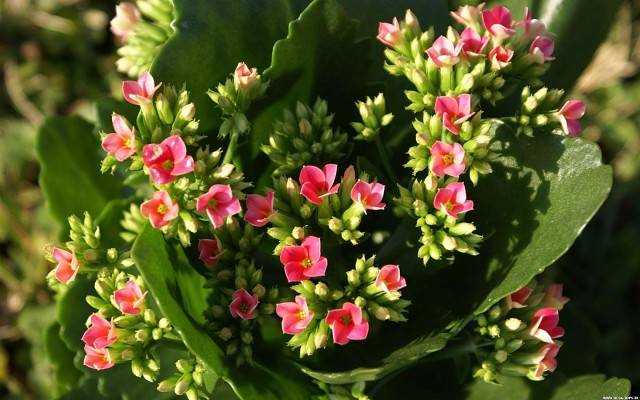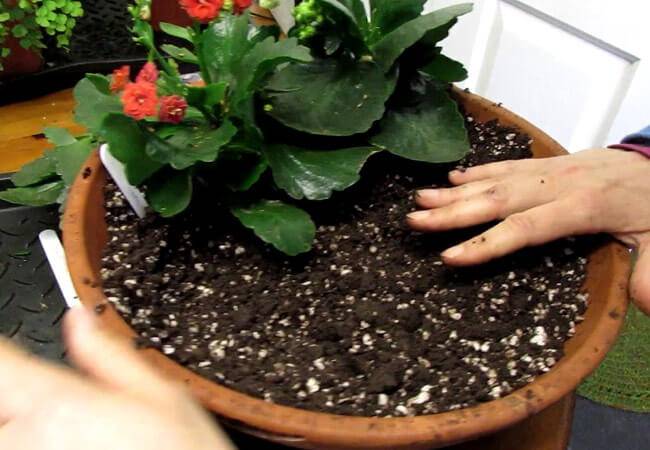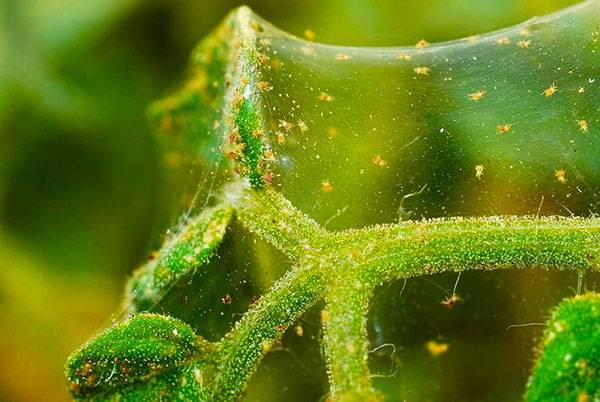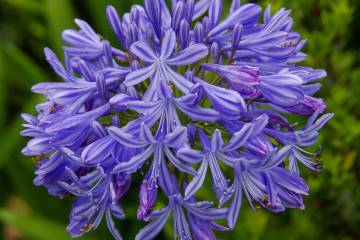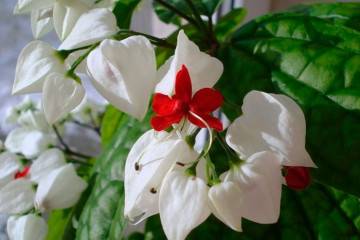Kalanchoe outdoors in the open field - can it be planted outside
Content:
Kalanchoe is a succulent from the Fat family. At home in South Africa and Asia, there are more than 200 species. How to grow a tropical Kalanchoe in the garden, planting and caring for a plant outdoors are described in this article.
Kalanchoe: is it possible to plant in open ground
Kalanchoe has been used for a long time in indoor floriculture. In many homes, it is found in a pot on a windowsill. The popularity of the plant is ensured not only by beautiful flowers, similar to small roses, dense variegated leaves, but also by the medicinal properties of its juice. Leaving a stuffy city in the summer, I want to plant a Kalanchoe in the country. Can Kalanchoe be planted outside? Planting a home doctor in the open field will not cause much difficulty.
Description of the houseplant Kalanchoe
The Kalanchoe genus is rich in species, several of them are cultivated at home, differing in the appearance of foliage and inflorescences. In most cases, this plant is up to 50 cm high. Leaves are medium or dark green dense leathery, often variegated. Kalanchoe is a succulent that accumulates moisture in foliage. The edge of the leaf plate is serrated; in many species, brood buds with roots are formed on it.
The paniculate inflorescence bears small flowers of pink, red, white, yellow, orange, depending on the variety.
Novice flower growers ask if it is possible to take out Kalanchoe Street in the summer? A loggia or terrace flooded with the summer sun will be an excellent place to grow this plant. The main thing is to water the flower in time and shade it from direct rays. In addition, the plant can be easily grown outdoors.
Planting Kalanchoe in open ground in the country
Kalanchoe in the open air in the garden, subject to the conditions of planting and care, feels good. It is used in flower beds as a specimen plant and in borders (undersized forms).
Below are the features of the microclimate and agricultural technology necessary to successfully grow Kalanchoe on the street.
Temperature regime for the plant
A street Kalanchoe is planted after the frost has passed, and the soil and air have warmed up enough. In Central Russia, the Moscow region, such conditions occur in the first decade of June. A plant that has wintered at home must undergo acclimatization: 2-3 days before transplanting it is taken out for several hours to fresh air, on the last day it can be left overnight.
Kalanchoe tolerates air temperatures from 12 ° C to 30 ° C practically without problems. The temperature regime at which the plant is most comfortable is 16 ° C to 18 ° C.
Humidity of air and soil
The flower is not picky about air humidity. It tolerates drought at high temperatures and excessive humidity at low temperatures.
Sensitive to substrate moisture. Watering is necessary abundant and regular. If the plant grows in partial shade, the intensity of watering should be reduced. The main thing is to make sure that the clod of earth does not dry out.
Location and lighting
Kalanchoe is not demanding on lighting.The only thing to avoid is direct sunlight as this can cause burns. With a strong lack of sun, the flowers of the plant will become small and inconspicuous.
Features of feeding
Kalanchoe, like other succulents, is bad for foliar dressing, but it responds well to root dressing.
For top dressing, experts advise choosing complex products. They are easier to dose and contain a full range of macro and micronutrients. The following ratio is considered optimal:
- 20% nitrogen;
- 8% phosphorus;
- 20% potassium.
The drug is diluted in water: 5.5 g per 2 liters. Watering is carried out twice a month. At the end of summer, the frequency of fertilizing is reduced, by autumn, it is stopped.
If, 2-3 days after feeding, yellow twisted leaves appear on the plant, you need to stop fertilizing.
Transplant specifics
Planting and transplanting a Kalanchoe is a fairly simple procedure. The main thing is to choose a suitable place and correctly form the soil mixture. Here is the approximate composition of the soil that needs to be filled in the holes:
- deciduous land - 2 parts;
- sod land - 2 parts;
- compost - 1 part;
- sand - 1 part.
The mixture, prepared by yourself, can be replaced with purchased soil for succulents.
Growing Kalanchoe on the street: conditions and care
Sometimes Kalanchoe in the country is planted in pots or flowerpots. When planting in an outdoor flowerpot, you need to follow the following scheme:
- Pick up a pot. It must be remembered that the plant feels better in a spacious container than in a cramped one.
- Cover the bottom with a drainage layer.
- Inspect the roots of the plant for rot and damage. Remove everything unnecessary, trying not to completely destroy the earthen lump.
- Place the roots in a new pot, adding fresh soil.
- Mulch with small pebbles.
If a decision is made to plant Kalanchoe in a flower bed, then it is better to stop at small plants. After planting, the plant must be watered abundantly. In order for the flower to please all summer, you need to follow agricultural techniques and growing conditions.
Possible difficulties
When planting Kalanchoe in open ground, the plant will be stressed. The florist must help him adapt with the least amount of loss. Stressogenic factors will be:
- change of microclimate;
- soil change;
- attacks of pests and pathogens;
- changing the light mode.
In the garden, in the fresh air, the likelihood of encountering pests and diseases increases significantly.
Pests
In the open field, Kalanchoe is affected by aphids and spider mites.
Aphids are often introduced to plants by ants, therefore, if there are a lot of them on the site and, even more so, on a specific plant, you need to be especially careful. Small translucent insects pierce the veins of the plant, suck out its juices, covering the leaves and stems with a sticky coating, provoking the reproduction of molds.
For a small amount of aphids, a strong soapy solution will help. If there are a lot of parasites, plant pruning and insecticide treatment will be required.
The spider mite settles on the lower surface of the leaf, gradually enveloping young shoots and leaves with sticky cobwebs. Just like aphids, it feeds on plant juices. The leaves become tough, turn yellow, their edges die off. The fight consists in treatment with soapy water or complex insecticides-acaricides (fitoverm, vermitek, etc.).
Diseases
In cool weather with abundant moisture, especially at the end of summer, gray rot may appear on the Kalanchoe.The leaves become sticky to the touch, covered with a gray bloom. If left unchecked, the foliage of the entire plant will turn into mush.
At elevated temperatures, combined with high humidity and stagnant air, the plant is affected by powdery mildew. This disease manifests itself in the appearance of white spots with a gray mealy bloom.
The methods of dealing with mold and mealy fungi are the same:
- establish an irrigation regime;
- adjust (if possible) the temperature;
- treat with fungicides.
Kalanchoe in the open field looks most advantageous in pots, flowerpots, pots. If you plant a plant in this way, it can be put on a flower bed on a sunny day and brought into the house in case of bad weather. In outdoor conditions, it is impossible to overmoisten the plant and leave it in direct sunlight. And most importantly, do not forget to bring it back home with the onset of a cold autumn.

